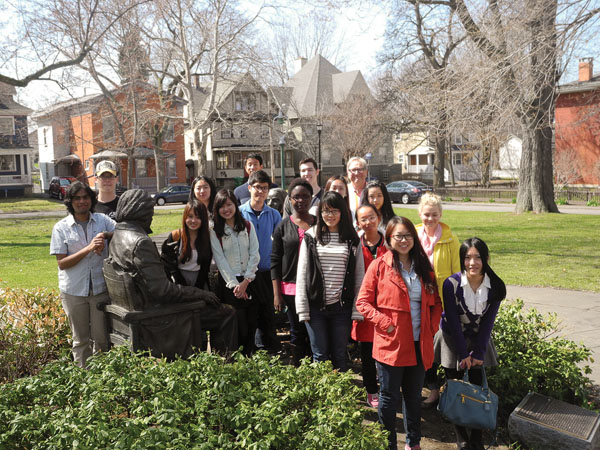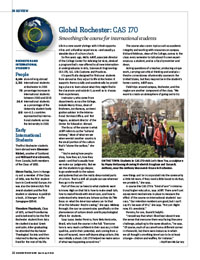In Review
 ON THE TOWN: Students in CAS 170 visit Let’s Have Tea, a sculpture by Pepsy Kettavong showing Frederick Douglass and Susan B. Anthony, near the Anthony Museum & House in Rochester. (Photo: Provided)
ON THE TOWN: Students in CAS 170 visit Let’s Have Tea, a sculpture by Pepsy Kettavong showing Frederick Douglass and Susan B. Anthony, near the Anthony Museum & House in Rochester. (Photo: Provided)Life in a new country brings with it fresh opportunities and unfamiliar experiences—and usually, a sizeable dose of culture shock.
Rochester and International Students
People
8,146 alumni living abroad
2,755 international students at Rochester in 2015
78 percentage increase in international students between 2010 and 2015
24.4 international students as a percentage of the University student body
118 non–U.S. countries represented by international students across the University in 2015
Early International Students
The first Rochester students born abroad were Ebenezer Nisbet, a native of Scotland, and William Peters Everett, from Canada, both members of the Class of 1853.
Simon Tuska, born in Hungary and a member of the Class of 1856, was the first student born in Continental Europe. He was also the University’s first Jewish student and the first student or alumnus to publish a book, A Stranger in the Synagogue (1854).
Theodore Thanbyah, Class of 1871, arrived from Burma and is believed to be the first Rochester student from Asia. He studied classical Greek and Latin. After graduating, he attended the Rochester Theological Society and then returned to Burma, where he lived for the rest of his life.
So five years ago, Molly Jolliff, associate director of the College Center for Advising Services, devised a program that’s now offered to all new international undergraduates in Arts, Sciences & Engineering: CAS 170, U.S. Life: Customs and Practices.
It’s specifically designed for first-year students from abroad as they adjust to life at Rochester. It supports them socially and academically by providing a place to learn about what they might find in the classroom and outside it, as well as to discuss their experiences.
Instructors, who come from departments across the College, include Marcy Kraus, dean of freshmen, Jon Ramsey, an immigration advisor in the International Services Office, and Ted Pagano, assistant director of the Center for Education Abroad.
The focus of the course is what Jolliff refers to as the “cultural iceberg.” Most of what we see when we visit another country is the small portion of the culture that’s “above the surface,” she says.
“You’re seeing how people dress, how they act, how they speak—and that’s usually how we make our judgments. But we ask the students to go deeper, to go underneath to the values and systems that are the really deep-rooted parts of culture. That’s a skill all people can use wherever they go in the world.”
Part of the course hews to what students want to know. High on that list is how to make small talk, how to make friends with Americans, and how to understand why Americans behave as they do.“We focus on what the American values can be that drive the behavior they’re seeing,” she says. Midway through, the course concentrates specifically on the phenomenon of culture shock and its psychological effects for students.
Says Lucas Avelar Pereira, from Belo Horizonte, Brazil, who took the course in the fall: “Everyone here is very much confident in their success, in their qualities, and in their potential, and coming from a less self-assured, more self-deprecating culture, this was initially a shock. CAS 170 helped me make sense of what was happening around me.”
The course also covers topics such as academic integrity and working with resources on campus. Richard Feldman, dean of the College, comes to the class every semester to talk about his own experiences as a student, and as a faculty member and dean.
Asking questions of a teacher, producing unique work, carrying out critical thinking and analysis—they’re cornerstones of university courses in the United States, but they may not be in the student’s home country, Jolliff says.
Field trips around campus, Rochester, and the region are another component of the class. “We want to create an atmosphere of going out to try new things and be incorporated into the community a little bit more. If they need a little boost to do that, we provide it,” she says.
A course like CAS 170 is “kind of rare” in international higher education, says Jolliff. There aren’t yet assessment mechanisms in place to measure the effect of the course on international students’ success. “Our retention numbers are good, but I can’t say it’s because of this,” she says. “Not yet. Right now, it’s anecdotal.”
Pereira, for one, found it helpful.
“I would say that what I liked best about it was the sense that everyone there was facing the same challenge, adapting to the same situation,” he says. “Of course, each of us came from a different corner in the world, but there were instances in which we all thought something American to be at least strange—chicken and waffles, for instance.”
—Kathleen McGarvey

